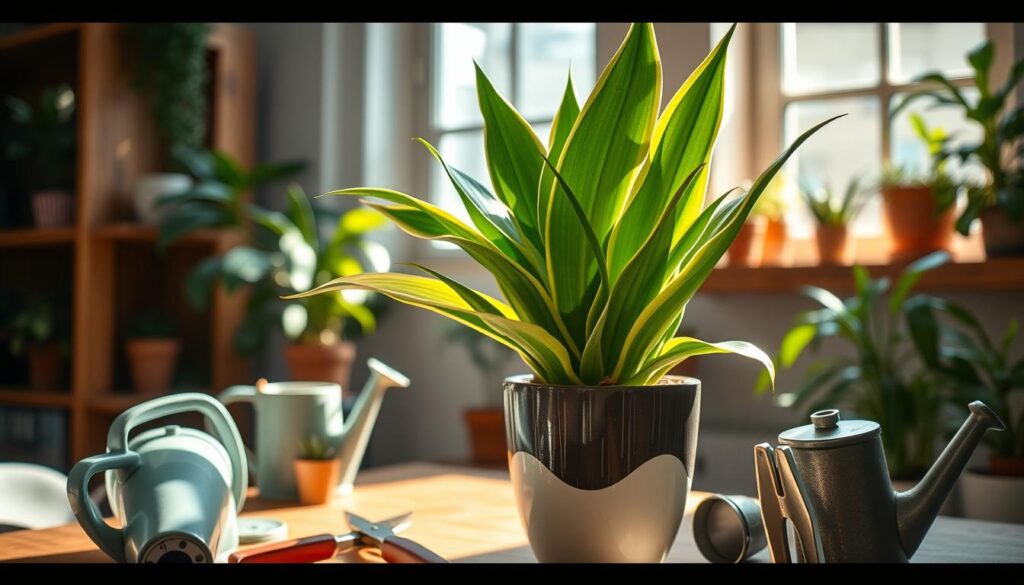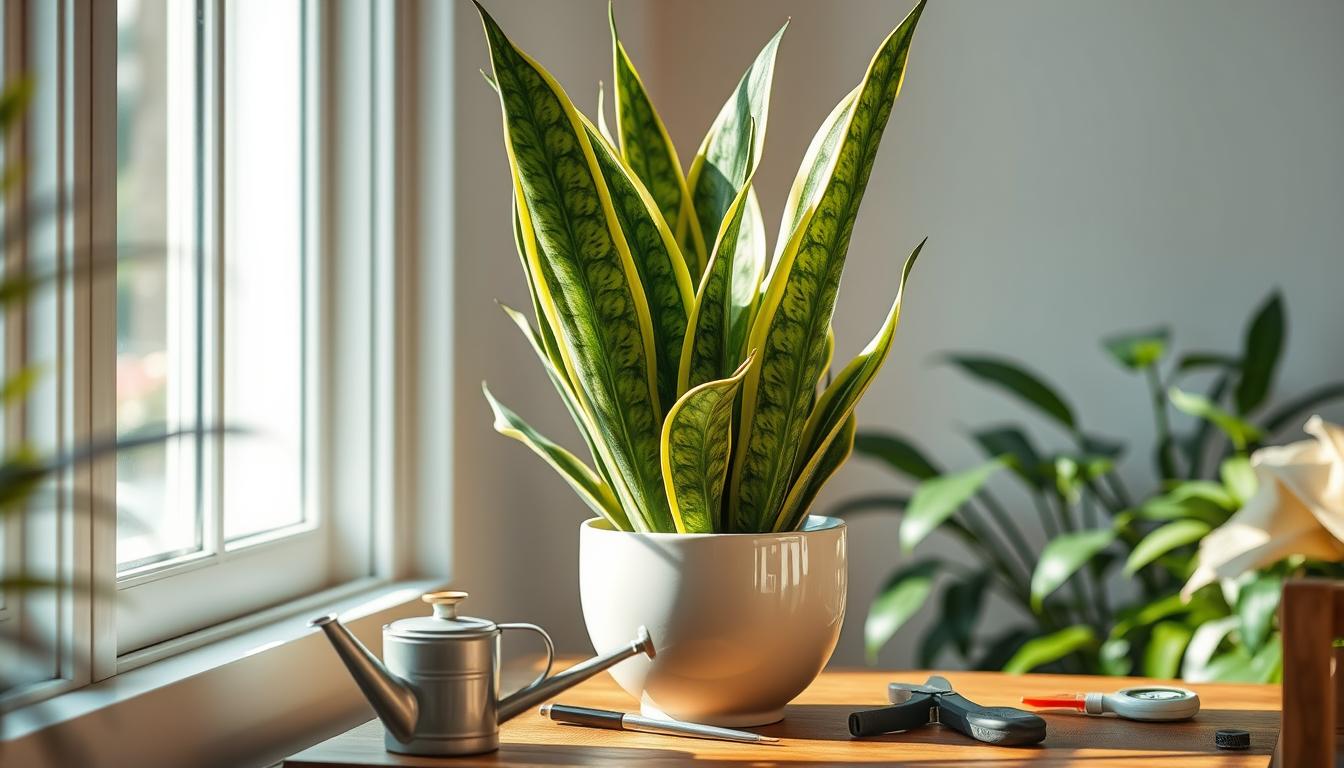Having a snake plant in your home can be a great way to purify the air and add some greenery to your space. With a Snake Plant care guide, you can learn how to keep your plant thriving. In this article, we will explore the benefits of having a snake plant and provide tips on Snake Plant care.
Whether you’re a seasoned gardener or a beginner, this guide will help you understand why snake plants are perfect for busy people. With their low-maintenance requirements, you can enjoy the benefits of having a plant without spending too much time on upkeep.
Key Takeaways
- Snake plants are low-maintenance and easy to care for
- They are perfect for busy people who want to purify the air and add greenery to their space
- A Snake Plant care guide can help you learn how to keep your plant thriving
- Snake plants can tolerate cold temperatures and require minimal watering
- With proper Snake Plant care, you can enjoy the benefits of having a plant without spending too much time on upkeep
- Our guide will provide you with tips and tricks on how to care for your snake plant
- By following our Snake Plant care guide, you can keep your plant healthy and thriving
Introduction to Snake Plants: A Perfect Houseplant
Sansevieria trifasciata, commonly known as snake plants, are a popular choice for indoor plants due to their ability to thrive in low-light conditions, making them one of the best plants for low-light rooms. They are perfect for rooms with limited natural light, such as apartments or offices, and can survive with minimal maintenance.
When it comes to Sansevieria trifasciata light needs, they can tolerate a range of lighting conditions, from low to bright indirect light. This versatility makes them an excellent option for anyone looking for a low-maintenance houseplant. Some of the benefits of having a snake plant include:
- Air purification properties, which can help remove toxins from the air
- Low water requirements, making them perfect for busy people or those new to plant care
- Attractive, upright leaves that can add a touch of greenery to any room
Snake plants are a great choice for anyone looking to bring some life into their home or office. With their ability to thrive in low-light conditions and low maintenance requirements, they are an excellent option for those who want to enjoy the benefits of having plants without the hassle.
In the next section, we will explore the key benefits of snake plants for homes, including their air purification properties and low water requirements.
| Plant Type | Light Requirements | Water Requirements |
|---|---|---|
| Sansevieria Trifasciata | Low to bright indirect light | Low |
| Other Low-Light Plants | Varying light requirements | Varying water requirements |
Key Benefits of Snake Plants for Homes
Snake plants are a popular choice for indoor spaces due to their unique blend of beauty and functionality. As Air-purifying indoor plants, they help remove toxins and pollutants from the air, creating a healthier environment for occupants. Their ability to thrive in low-light conditions and survive with minimal watering makes them ideal Drought-tolerant houseplants for busy individuals or those new to plant care.
Some of the key benefits of snake plants include:
- Air purification properties, which help remove harmful toxins from the air
- Low water requirements, making them perfect for those who tend to forget to water their plants
- Low maintenance care, allowing them to thrive in a variety of conditions
By incorporating snake plants into your home, you can enjoy the benefits of Air-purifying indoor plants while also adding a touch of natural beauty to your space. With their ability to survive with minimal care, snake plants are an excellent choice for anyone looking to bring some greenery into their home.
Whether you’re a seasoned plant enthusiast or just starting out, snake plants are an excellent addition to any indoor space. Their unique blend of form and function makes them a popular choice for homes and offices alike, and their Air-purifying properties make them a great choice for improving indoor air quality.
Ideal Growing Conditions for Snake Plants
To keep your snake plant happy and healthy, it’s essential to provide it with the right growing conditions. This includes understanding the ideal light preferences and temperature tolerance for snake plants. By following a Snake Plant care guide, you can ensure your plant thrives in any environment.
Snake plants can tolerate a wide range of light conditions, from low to bright light. However, they prefer bright, indirect light for optimal growth. When it comes to temperature, snake plants prefer a Snake Plant temperature range of 65-75°F (18-24°C). Avoid placing your snake plant near heating or cooling vents, fireplaces, or drafty windows.
Light Preferences
Here are some tips for providing the right light conditions for your snake plant:
- Place your snake plant near an east- or west-facing window for bright, indirect light.
- Avoid placing your snake plant in direct sunlight, as this can cause the leaves to become scorched.
- If you don’t have a sunny window, you can also use grow lights to provide the necessary light for your snake plant.
Temperature Tolerance
Snake plants are relatively tolerant of temperature fluctuations, but they prefer a consistent temperature range. Here are some tips for maintaining the right temperature for your snake plant:
- Keep your snake plant away from heating or cooling vents, fireplaces, or drafty windows.
- Avoid placing your snake plant near air conditioning units or space heaters.
- Use a thermometer to monitor the temperature in your home and adjust the location of your snake plant as needed.
How to Water Your Snake Plant
Watering your snake plant can be a bit tricky, but with the right Snake Plant watering tips, you can keep your plant happy and healthy. As a Drought-tolerant houseplant, snake plants can survive with minimal watering, but they still need some care to thrive.
To avoid overwatering, check the soil moisture by sticking your finger into the soil up to the first knuckle. If the soil feels dry, it’s time to water your snake plant. Here are some signs of overwatering to watch out for:
- Yellowing leaves
- Soft, mushy stems
- Water pooling in the soil
A recommended watering schedule for snake plants is to water them once a week in the summer and once every 10-14 days in the winter. However, this may vary depending on the humidity and temperature of your environment. By following these Snake Plant watering tips, you can keep your Drought-tolerant houseplants happy and thriving.
Remember, it’s always better to err on the side of caution and underwater slightly, as snake plants can recover from underwatering more easily than overwatering. With the right care and attention, your snake plant will be a beautiful and low-maintenance addition to your home.
| Season | Watering Frequency |
|---|---|
| Summer | Once a week |
| Winter | Once every 10-14 days |
Fertilizing Snake Plants for Optimal Growth
Fertilizing your snake plant is an essential part of a comprehensive Snake Plant care guide. To keep your Air-purifying indoor plants thriving, you need to provide them with the necessary nutrients. When it comes to fertilizing snake plants, it’s crucial to choose the right type of fertilizer and apply it correctly.
Types of Fertilizer to Use
There are several types of fertilizers available, including water-soluble and slow-release fertilizers. For snake plants, a balanced, water-soluble fertilizer is recommended. You can also use a fertilizer specifically formulated for indoor plants, which will provide the necessary nutrients for healthy growth.
Frequency of Application
The frequency of fertilization depends on the growth stage of your snake plant. During the growing season, which typically occurs in the spring and summer, you can fertilize your plant once a month. In the fall and winter, when the plant is dormant, you can reduce fertilization to once every two months.
Here are some tips for fertilizing your snake plant:
- Use a balanced fertilizer that contains equal amounts of nitrogen, phosphorus, and potassium.
- Avoid overfertilizing, as this can damage the roots and leaves of your plant.
- Water your plant thoroughly after fertilizing to prevent burning the roots.
By following these tips and using the right type of fertilizer, you can keep your snake plant healthy and thriving. Remember to always follow the instructions on the fertilizer package and take necessary precautions to avoid overfertilizing.
| Fertilizer Type | Frequency of Application | Benefits |
|---|---|---|
| Water-soluble fertilizer | Once a month | Promotes healthy growth and development |
| Slow-release fertilizer | Once every two months | Provides long-lasting nutrients and reduces the need for frequent fertilization |
Propagation Methods for Snake Plants
Snake plants are one of the best plants for low-light rooms, making them a popular choice for indoor spaces. Propagating these plants is a great way to share them with friends and family or to create new plants for your home. There are several Snake Plant propagation methods, including leaf cuttings and division.
To propagate a snake plant using leaf cuttings, simply cut off a healthy leaf, allow it to dry for a few days, and then plant it in well-draining soil. The division method involves separating the roots of a mature plant and replanting the separated sections. Both methods can be effective, but the division method tends to produce more consistent results.
Some tips for successful propagation include using a well-draining potting mix, keeping the soil consistently moist, and providing indirect light. By following these tips and using one of the Snake Plant propagation methods, you can easily share your snake plant with others or create new plants for your home.
| Propagation Method | Description |
|---|---|
| Leaf Cuttings | Cut off a healthy leaf, allow it to dry, and plant in well-draining soil |
| Division | Separate the roots of a mature plant and replant the separated sections |
Common Pests and Diseases Affecting Snake Plants
As a low-maintenance houseplant, snake plants are generally easy to care for, but like any other plant, they can be susceptible to pests and diseases. A good Snake Plant care guide should include information on common pests and diseases.
Some common pests that can affect snake plants include mealybugs, spider mites, and scale. These pests can cause damage to the plant’s leaves and stems, and can also spread disease. Regular inspection and proper care can help prevent infestations. Air-purifying indoor plants like snake plants can be especially vulnerable to pests if not properly cared for.
Identifying Common Pests
To identify common pests, look for signs such as white powdery patches, sticky substance on the leaves, or actual pests on the plant. It’s essential to catch infestations early to prevent them from spreading and causing further damage.
Tips for Prevention and Treatment
Prevention is key when it comes to protecting your snake plant from pests and diseases. Make sure to water your plant properly, and avoid overwatering, which can lead to root rot and other problems. Regularly inspect your plant, and isolate it if you notice any signs of infestation. With proper care and attention, your snake plant can thrive and remain a beautiful, air-purifying indoor plant.
| Pest | Signs | Treatment |
|---|---|---|
| Mealybugs | White powdery patches | Insecticidal soap |
| Spider mites | Sticky substance on leaves | Neem oil |
| Scale | Actual pests on plant | Horticultural oil |
Pruning Your Snake Plant: When and How?
Pruning is an essential part of a Snake Plant care guide, as it helps maintain the plant’s shape and promotes healthy growth. By pruning your Snake Plant, you can encourage new leaves to grow and prevent the plant from becoming leggy. This is especially important for plants grown in low-light rooms, as they may stretch towards the light source.
When it comes to pruning, there are a few key things to keep in mind. Timing is everything, as pruning at the wrong time can cause more harm than good. It’s best to prune your Snake Plant during the spring and summer months when it’s actively growing. This allows the plant to quickly recover from any pruning and minimizes the risk of disease or pest issues.
Here are some steps to follow when pruning your Snake Plant:
- Remove any dead or damaged leaves to prevent the spread of disease
- Cut back tall leaves to maintain the plant’s shape and encourage new growth
- Use clean, sharp tools to prevent spreading disease

By following these simple steps and incorporating pruning into your Snake Plant care guide, you can keep your plant looking its best and thriving in even the lowest-light rooms. As one of the Best plants for low-light rooms, the Snake Plant is a great choice for anyone looking to add some greenery to their space.
| Pruning Tool | Purpose |
|---|---|
| Pruning shears | Removing dead or damaged leaves |
| Long-handled pruning tool | Cutting back tall leaves |
The Best Pots for Snake Plant Care
When it comes to choosing the right pot for your Snake Plant, there are several factors to consider. As a Drought-tolerant houseplant, Snake Plants require well-draining soil to prevent root rot. A pot with proper drainage holes is essential to ensure the health and happiness of your plant. You can find more information on the best pots for Snake Plants by visiting a Snake Plant care guide website.
In addition to drainage, the size of the pot is also crucial. A pot that is too small can cause the soil to dry out too quickly, while a pot that is too large can cause the soil to become waterlogged. Here are some tips to consider when choosing the right size pot for your Snake Plant:
- Choose a pot that is only 1-2 sizes larger than the current pot.
- Consider the mature size of the plant and choose a pot that will accommodate its growth.
- Make sure the pot has drainage holes to prevent waterlogged soil.
By following these tips and choosing the right pot for your Snake Plant, you can help ensure the health and happiness of your plant. Remember to repot your Snake Plant every 2-3 years to provide fresh soil and a larger pot if necessary. With the right pot and proper care, your Snake Plant can thrive and become a beautiful and low-maintenance addition to your home.
Seasonal Care Tips for Snake Plants
As a low-maintenance houseplant, snake plants are relatively easy to care for, but they do have different needs during different seasons. To keep your snake plant thriving, it’s essential to adjust your care routine according to the time of year. A well-crafted Snake Plant care guide can help you navigate these seasonal changes.
In the winter months, snake plants require less water and fertilizer, as they are dormant. This is a great time to focus on pruning and repotting, if necessary. On the other hand, during the summer, snake plants need more frequent watering and fertilization to support their growth. By following these seasonal care tips, you can help your snake plant flourish and continue to purify the air in your home, making it one of the best Air-purifying indoor plants.
Winter Care Needs
- Reduce watering to once a month
- Stop fertilizing until spring
- Prune dead or damaged leaves
Summer Growth Practices
- Water every 1-2 weeks
- Fertilize monthly with a balanced fertilizer
- Provide bright, indirect light
Troubleshooting Snake Plant Issues
When it comes to Snake Plant care, it’s essential to identify and address any issues promptly to ensure your plant remains healthy and thriving. A well-crafted Snake Plant care guide can help you navigate common problems and provide solutions to get your plant back on track. If you’re looking for the Best plants for low-light rooms, Snake Plants are an excellent choice, but they still require proper care to flourish.
Yellowing Leaves: What It Means
Yellowing leaves can be a sign of overwatering or underwatering. To prevent this, make sure to check the soil moisture regularly and adjust your watering schedule accordingly. A good Snake Plant care guide will provide you with tips on how to water your plant correctly.
Stunted Growth Solutions
To promote healthy growth, ensure your Snake Plant is receiving sufficient light and nutrients. Consider fertilizing your plant during the growing season to provide it with the necessary nutrients. By following these tips and referring to a reliable Snake Plant care guide, you can help your plant thrive, even in low-light conditions, making it one of the Best plants for low-light rooms.
Resources and Further Reading on Snake Plant Care
If you’re looking to deepen your knowledge of snake plant care, there are numerous resources available. From informative books to online communities, you can find a wealth of information to help you become a true snake plant expert.
Recommended Books
For a comprehensive guide on growing and maintaining healthy snake plants, we suggest checking out “The Complete Guide to Snake Plants” by gardening enthusiast Emily Walters. This book covers all aspects of snake plant care, from propagation techniques to troubleshooting common issues.
Online Communities and Forums
Connecting with other snake plant enthusiasts can be a great way to learn new tips and tricks. Join online forums like the r/succulents subreddit or the Snake Plant Lovers Facebook group to ask questions, share your own experiences, and discover new insights on caring for your snake plant.






Pingback: Aspidistra (Cast Iron Plant): The Indestructible Cold-Tolerant Houseplant for Any Home
Pingback: 10 Stunning Large Indoor Plants for Statement Decor - Trusted House Plant Guide
Pingback: Ultimate Guide to DIY Houseplant Projects: Transform Your Space with Creative Plant Ideas - Trusted House Plant Guide
Pingback: Busy Lives, Easy Plants: Top 5 Low-Maintenance Houseplants for the Busy Bee - Trusted House Plant Guide
Pingback: Furry Friends and Foliage: Choosing Pet-Friendly Indoor Plants - Trusted House Plant Guide
Pingback: Nurturing Nature: Sustainable Strategies for Indoor Plant Care - Trusted House Plant Guide
Pingback: Exclusive Botanicals: Mastering the Care of Exotic and Unusual Houseplants - Trusted House Plant Guide
Pingback: Tender Care: A Guide to Baby Rubber Plant Nurturing - Trusted House Plant Guide
Pingback: 10 Statement Houseplants to Create Your Dream Indoor Jungle - Trusted House Plant Guide
Pingback: 10 Best Low-Light Houseplants for a Lush Indoor Oasis - Trusted House Plant Guide
Pingback: 10 Gorgeous Houseplants That Thrive in Humidity - Trusted House Plant Guide
Pingback: Troubleshooting Common Indoor Plant Problems: A Comprehensive Guide - Trusted House Plant Guide
Pingback: How to Make a Beautiful Succulent Terrarium: A Step-by-Step Tutorial - Trusted House Plant Guide
Pingback: Pure Air, Pure Home: The Ultimate Guide to Air-Purifying Indoor Plants - Trusted House Plant Guide
Pingback: The Ultimate Guide to Houseplants: 100 Best Indoor Plants for Every Home - Trusted House Plant Guide
Pingback: Seasons of Growth: Adapting Your Indoor Plant Care for Each Season - Trusted House Plant Guide
Pingback: Rubber Plant: The Resilient Houseplant That Can Withstand Cool Indoor Temperatures
Pingback: "ZZ Plant Magic: Easy Steps to Lush, Healthy Growth" - Trusted House Plant Guide
Pingback: Succulent Types & Care - Trusted House Plant Guide
Pingback: The Ultimate Beginner's Guide to the Most Wanted Indoor Plant for 2025 - Trusted House Plant Guide
Pingback: 12 Stunning Indoor Succulents and Cacti for Your Home - Trusted House Plant Guide
Pingback: 10 Perfect Small Houseplants for Compact Spaces - Trusted House Plant Guide
Pingback: 8 Stunning Flowering Indoor Plants to Brighten Your Home - Trusted House Plant Guide